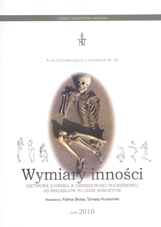Rolnik, wojownik czy „odmieniec”? Próba interpretacji obecności sierpów w grobach wczesnośredniowiecznych na terenie ziem polskich
Farmer, warrior or „outsider”? Attempt of interpretation of the presence of sickles in early medieval graves in Polish land
Author(s): Andrzej Janowski, Tomasz KurasińskiSubject(s): Archaeology
Published by: Łódzkie Towarzystwo Naukowe
Summary/Abstract: The present text focuses on an attempt to analyze the presence of sickles in graves. Bibliographic query from the Polish lands revealed only 22 finds of sickles within cemetery space, out of which only 12 could be undoubtedly related to early medieval graves (see the catalog). Confrontation of anthropological and archaeological data has not shown any regularities in the custom of placing sickles in graves. They were placed both in female (Czersk, Jaksice, Napole) and in male graves (Brzeg, Święck-Strumiany, Tomice) of persons of different age (adultus – Czersk, Tomice; maturus – Brzeg, Święck-Strumiany; dorosły – Brześć Kujawski), placed with the head pointing westward (Brzeg, Czersk, Kałdus, Święck-Strumiany, Tomice) or eastward (Brześć Kujawski, Końskie, Napole, Sandomierz). In majority of cases they were single graves, and only in Sandomierz and Czersk these graves contained more than one person. A usually peripheral location of a grave within the cemetery space is, however, worth noticing. The inventories in the discussed graves were rather impecunious, and the sickle was often the only object found at the dead (see the catalog). Its location within a grave space was diversified. In three cases it was placed near the pelvis (Tomice, Brześć Kujawski, Święck-Strumiany), in two cases at the lower limbs (Napole, Brzeg), while in Końskie at the right side of the skull, in Sandomierz at the chest and in Jaksice it was driven into the neck vertebrae (?). The above overview of finds suggests that the custom of equipping the dead with a sickle was not common in the Polish lands in early middle ages. This situation was similar to the other parts of Europe, with the exception of the Carpathian Basin and middle Danube, (Slovakia, Hungary, Lower Austria, western Romania) where the custom was relatively frequent. Some scholars think, that these were the areas, where the custom spread westwards and north-westwards in the 8th and 9th centuries. Three concepts explaining the presence of sickles in graves can be found in literature. The first one suggests it was a professional attribute, proving the jobs the dead used to perform while alive – in this case farming or in some relation to farming. The second hypothesis suggests that a sickle in a grave proves a relation to military issues, being a weapon and a tool useful during military expeditions. The third explanation of the phenomenon bases on a sickle’s apotropaic properties, guaranteeing that the dead remains in the location of the burial and would not harm the living. Each of these three concepts is proved by numerous, sometimes parallel arguments, but the authors tend to the last concept in explanation of the phenomenon. It is supported by: placing of the tool in contact with the dead body, peripheral location of the burials within a necropolis, lack of more numerous grave inventories and ethnographic data.
Journal: Acta Archaeologica Lodziensia
- Issue Year: 2010
- Issue No: 56
- Page Range: 79-96
- Page Count: 18
- Language: Polish

